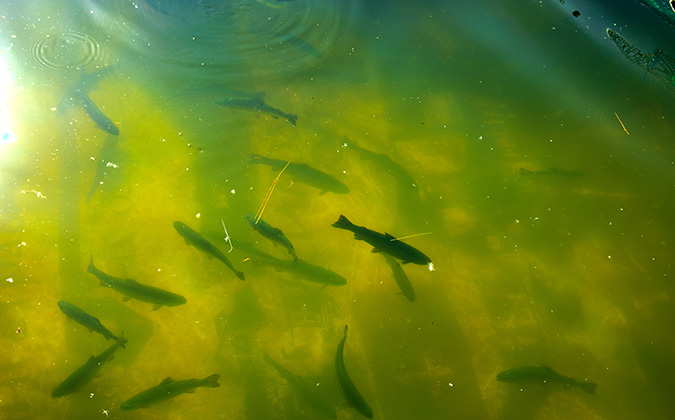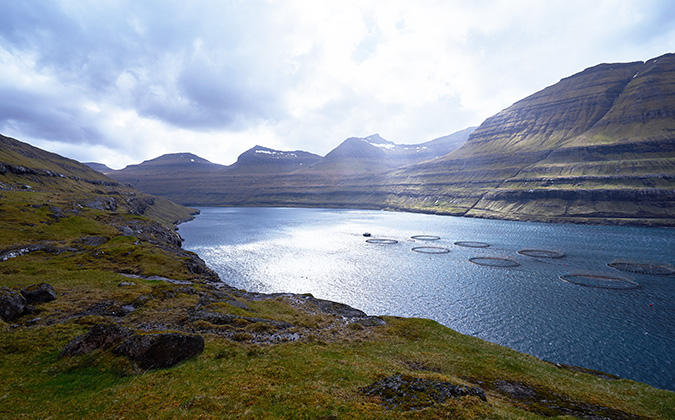
Tracking salmon through production offers new insight into gill disease
Gills coinfected with three or more pathogens is the “norm” in Western Norway’s salmon aquaculture, new field data suggests — but Neoparamoeba perurans is that which appears to be predominantly linked with gill disease.
Scientists from PHARMAQ Analytiq, Mowi ASA, VAI consulting and Norwegian University of Life Sciences followed groups of Atlantic salmon through the hatchery phase and in the first year following sea transfer to assess the impact of known gill pathogens.
As well as N. perurans, the cause of amoebic gill disease, they found Desmozoon lepeophtherii (syn. Paranucleospora theridion), Candidatus Branchiomonas cysticola (Ca. B. cysticola) and salmon gill poxvirus (SGPV) affecting fish in all groups when at sea. However, no tangible connections between D. lepeophtherii, Ca. B. cysticola and disease were reported in the team’s research, published in Journal of Fish Diseases.1 Poxvirus infection was associated with damage to the gill epithelium but not moderate to severe gill disease.
“We know from diagnostic work that N. perurans is an important cause of gill disease, and it is well-known that it does create problems for Norwegian salmon farmers, so in that sense, I’m not so surprised by the findings. I am more surprised that we didn’t find any clear evidence for an effect of the other microorganisms,” said Liv Østevik, who led the work together with Marta Alarcon, both of PHARMAQ Analytiq.
Unravelling complex picture
Although the results could show that, aside from N. perurans, the other pathogens studied are not as important as may have previously been thought in causing gill disease among sea-farmed salmon, she explained, it is possible that the lack of effects observed in the study could be due to the relatively low pathogen load and few fish developing severe gill disease during the research period.
“It could also suggest that there needs to be some other factors that lead to those infectious agents causing disease,” she continued.
In considering the shift from freshwater to sea, there was one notable finding. While several groups were infected with SGPV, only one group of fish in the study was found to have an outbreak of poxvirus-associated gill disease in the freshwater stage. However, compared to the other groups, fish in this population did not develop more severe gill disease after sea transfer.
Independently of SGPV status at sea transfer, all groups tested positive for SGPV at one or more time points at sea. This finding demonstrated the possibility that fish can become infected and repeatedly re-infected with the virus in the sea.
More avenues to explore gill disease
Previous work by the team had highlighted gill damage that can occur as a result of thermal and mechanical delousing techniques,2 as well as increases in levels of Ca. B. cysticola in the gills after thermal delousing. There remain unknowns about the potential for accumulated damage over multiple such treatments, as well as their impact if gill disease is already present at the outset of treatment, she stressed.
Further work based on the research is underway, involving statistical analysis of some of the data collected, Østevik said. She also suggested that a potentially fruitful future area of work could be cohabitation trials involving only Ca. B. cysticola, alongside immune suppression of fish, to see if disease develops.
Despite the expense associated with cohort studies such as the one just reported, she believes that there is value in doing more, similar work.
“If we follow fish over time, with several fish groups and farms included, it will ultimately be helpful in understanding gill disease better,” she added.
1 Østevik L, Stormoen M, Hellberg H, Kraugerud M, Manji F, Lie K, Nødtvedt A, Rodger H, Alarcón M. A cohort study of gill infections, gill pathology and gill‐related mortality in sea‐farmed atlantic salmon (salmo salar L.): A descriptive analysis. J Fish Dis. 2022.
2 Østevik L, Stormoen M, Evensen Ø, Xu C, Lie K, Nødtvedt A, Rodger H, Skagøy A, Manji F, Alarcon M. Effects of thermal and mechanical delousing on gill health of farmed Atlantic salmon (salmo salar L.). Aquaculture. 2022:738019.






